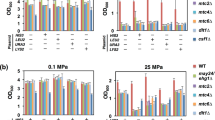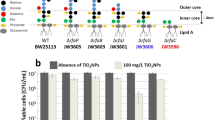Abstract
Bacteria are thought to cope with fluctuating environmental solute concentrations primarily by adjusting the osmolality of their cytoplasm. To obtain insights into the underlying metabolic adaptations, we analyzed the global metabolic response of Escherichia coli to sustained hyperosmotic stress using nontargeted mass spectrometry. We observed that 52% of 1,071 detected metabolites, including known osmoprotectants, changed abundance with increasing salt challenge. Unexpectedly, unsupervised data analysis showed a substantial increase of most intermediates in the ubiquinone-8 (Q8) biosynthesis pathway and a 110-fold accumulation of Q8 itself, as confirmed by quantitative lipidomics. We then demonstrated that Q8 is necessary for acute and sustained osmotic-stress tolerance using Q8 mutants and tolerance rescue through feeding nonrespiratory Q8 analogs. Finally, in vitro experiments with artificial liposomes showed that mechanical membrane stabilization is a principal mechanism of Q8-mediated osmoprotection. Thus, we find that besides regulating intracellular osmolality, E. coli enhances its cytoplasmic membrane stability to withstand osmotic stress.
This is a preview of subscription content, access via your institution
Access options
Subscribe to this journal
Receive 12 print issues and online access
$259.00 per year
only $21.58 per issue
Buy this article
- Purchase on Springer Link
- Instant access to full article PDF
Prices may be subject to local taxes which are calculated during checkout





Similar content being viewed by others
References
Bartlett, D.H. Pressure effects on in vivo microbial processes. Biochim. Biophys. Acta 1595, 367–381 (2002).
Record, M.T. Jr., Courtenay, E.S., Cayley, D.S. & Guttman, H.J. Responses of E. coli to osmotic stress: large changes in amounts of cytoplasmic solutes and water. Trends Biochem. Sci. 23, 143–148 (1998).
Vreeland, R.H. Mechanisms of halotolerance in microorganisms. Crit. Rev. Microbiol. 14, 311–356 (1987).
Krämer, R. Bacterial stimulus perception and signal transduction: response to osmotic stress. Chem. Rec. 10, 217–229 (2010).
Piuri, M., Sanchez-Rivas, C. & Ruzal, S.M. Cell wall modifications during osmotic stress in Lactobacillus casei. J. Appl. Microbiol. 98, 84–95 (2005).
Wood, J.M. Bacterial osmoregulation: a paradigm for the study of cellular homeostasis. Annu. Rev. Microbiol. 65, 215–238 (2011).
Calamita, G., Bishai, W.R., Preston, G.M., Guggino, W.B. & Agre, P. Molecular cloning and characterization of AqpZ, a water channel from Escherichia coli. J. Biol. Chem. 270, 29063–29066 (1995).
Laimins, L.A., Rhoads, D.B. & Epstein, W. Osmotic control of kdp operon expression in Escherichia coli. Proc. Natl. Acad. Sci. USA 78, 464–468 (1981).
Grothe, S., Krogsrud, R.L., McClellan, D.J., Milner, J.L. & Wood, J.M. Proline transport and osmotic stress response in Escherichia coli K-12. J. Bacteriol. 166, 253–259 (1986).
von Weymarn, N., Nyyssölä, A., Reinikainen, T., Leisola, M. & Ojamo, H. Improved osmotolerance of recombinant Escherichia coli by de novo glycine betaine biosynthesis. Appl. Microbiol. Biotechnol. 55, 214–218 (2001).
Giaever, H.M., Styrvold, O.B., Kaasen, I. & Strom, A.R. Biochemical and genetic characterization of osmoregulatory trehalose synthesis in Escherichia coli. J. Bacteriol. 170, 2841–2849 (1988).
Elbein, A.D., Pan, Y.T., Pastuszak, I. & Carroll, D. New insights on trehalose: a multifunctional molecule. Glycobiology 13, 17R–27R (2003).
Klein, W., Ehmann, U. & Boos, W. The repression of trehalose transport and metabolism in Escherichia coli by high osmolarity is mediated by trehalose-6-phosphate phosphatase. Res. Microbiol. 142, 359–371 (1991).
Cayley, S. & Record, M.T. Large changes in cytoplasmic biopolymer concentration with osmolality indicate that macromolecular crowding may regulate protein-DNA interactions and growth rate in osmotically stressed Escherichia coli K-12. J. Mol. Recognit. 17, 488–496 (2004).
Horta, B.A., Perić-Hassler, L. & Hünenberger, P.H. Interaction of the disaccharides trehalose and gentiobiose with lipid bilayers: a comparative molecular dynamics study. J. Mol. Graph. Model. 29, 331–346 (2010).
Pereira, C.S. & Hünenberger, P.H. Effect of trehalose on a phospholipid membrane under mechanical stress. Biophys. J. 95, 3525–3534 (2008).
Fuhrer, T., Heer, D., Begemann, B. & Zamboni, N. High-throughput, accurate mass metabolome profiling of cellular extracts by flow injection-time-of-flight mass spectrometry. Anal. Chem. 83, 7074–7080 (2011).
Landis, L., Xu, J. & Johnson, R.C. The cAMP receptor protein CRP can function as an osmoregulator of transcription in Escherichia coli. Genes Dev. 13, 3081–3091 (1999).
Balsalobre, C., Johansson, J. & Uhlin, B.E. Cyclic AMP-dependent osmoregulation of crp gene expression in Escherichia coli. J. Bacteriol. 188, 5935–5944 (2006).
Shen, B., Hohmann, S., Jensen, R.G. & Bohnert, H.J. Roles of sugar alcohols in osmotic stress adaptation. Replacement of glycerol by mannitol and sorbitol in yeast. Plant Physiol. 121, 45–52 (1999).
Gunasekera, T.S., Csonka, L.N. & Paliy, O. Genome-wide transcriptional responses of Escherichia coli K-12 to continuous osmotic and heat stresses. J. Bacteriol. 190, 3712–3720 (2008).
Ejsing, C.S. et al. Global analysis of the yeast lipidome by quantitative shotgun mass spectrometry. Proc. Natl. Acad. Sci. USA 106, 2136–2141 (2009).
Søballe, B. & Poole, R.K. Ubiquinone limits oxidative stress in Escherichia coli. Microbiology 146, 787–796 (2000).
Smirnova, G.V., Muzyka, N.G. & Oktyabrsky, O.N. The role of antioxidant enzymes in response of Escherichia coli to osmotic upshift. FEMS Microbiol. Lett. 186, 209–213 (2000).
Kalir, A. & Poljakoff-Mayber, A. Changes in activity of malate dehydrogenase, catalase, peroxidase and superoxide dismutase in leaves of Halimione portulacoides (L.) aellen exposed to high sodium chloride concentrations. Ann. Bot. 47, 75–85 (1981).
Stroobant, P., Young, I.G. & Gibson, F. Mutants of Escherichia coli K-12 blocked in the final reaction of ubiquinone biosynthesis: characterization and genetic analysis. J. Bacteriol. 109, 134–139 (1972).
Kanai, T., Takahashi, K. & Inoue, H. Three distinct-type glutathione S-transferases from Escherichia coli important for defense against oxidative stress. J. Biochem. 140, 703–711 (2006).
Wu, G., Williams, H.D., Gibson, F. & Poole, K. Mutants of Escherichia coli affected in respiration: the cloning and nucleotide sequence of ubiA, encoding the membrane-bound p-hydroxybenzoate:octaprenyltransferase. J. Gen. Microbiol. 139, 1795–1805 (1993).
Pilizota, T. & Shaevitz, J.W. Fast, multiphase volume adaptation to hyperosmotic shock by Escherichia coli. PLoS ONE 7, e35205 (2012).
Paturej, J., Popova, H., Milchev, A. & Vilgis, T.A. Force-induced breakdown of flexible polymerized membrane. Preprint at http://arxiv.org/abs/1111.6719 (2012).
Katsikas, H. & Quinn, P.J. The polyisoprenoid chain length influences the interaction of ubiquinones with phospholipid bilayers. Biochim. Biophys. Acta 689, 363–369 (1982).
Roche, Y., Peretti, P. & Bernard, S. Influence of the chain length of ubiquinones on their interaction with DPPC in mixed monolayers. Biochim. Biophys. Acta 1758, 468–478 (2006).
De Rosa, M., Gambacorta, A. & Gliozzi, A. Structure, biosynthesis, and physicochemical properties of archaebacterial lipids. Microbiol. Rev. 50, 70–80 (1986).
Konings, W.N., Albers, S.-V., Koning, S. & Driessen, A.J.M. The cell membrane plays a crucial role in survival of bacteria and archaea in extreme environments. Antonie van Leeuwenhoek 81, 61–72 (2002).
Jacquemet, A., Barbeau, J., Lemiègre, L. & Benvegnu, T. Archaeal tetraether bipolar lipids: Structures, functions and applications. Biochimie 91, 711–717 (2009).
Houssin, C., Eynard, N., Shechter, E. & Ghazi, A. Effect of osmotic pressure on membrane energy-linked functions in Escherichia coli. Biochim. Biophys. Acta 1056, 76–84 (1991).
Jensen, M.Ø. & Mouritsen, O.G. Lipids do influence protein function-the hydrophobic matching hypothesis revisited. Biochim. Biophys. Acta 1666, 205–226 (2004).
Stachowiak, J.C. et al. Membrane bending by protein-protein crowding. Nat. Cell Biol. 14, 944–949 (2012).
Haines, T.H. Do sterols reduce proton and sodium leaks through lipid bilayers? Prog. Lipid Res. 40, 299–324 (2001).
Gruszecki, W.I., Smal, A. & Szymczuk, D. The effect of zeaxanthin on the thickness of dimyristoylphosphatidylcholine bilayer: X-ray diffraction study. J. Biol. Phys. 18, 271–280 (1992).
Ma, Y. et al. Study of the effect of membrane thickness on microcapsule strength, permeability, and cell proliferation. J. Biomed. Mater. Res. A 101, 1007–1015 (2013).
Gasser, D.L. et al. Focal segmental glomerulosclerosis is associated with a PDSS2 haplotype and, independently, with a decreased content of coenzyme Q10. Am. J. Physiol. Renal Physiol. 305, F1228–F1238 (2013).
Ziegler, C.G.K. et al. Parkinson's disease-like neuromuscular defects occur in prenyl diphosphate synthase subunit 2 (Pdss2) mutant mice. Mitochondrion 12, 248–257 (2012).
Yoshida, H., Kotani, Y., Ochiai, K. & Araki, K. Production of ubiquinone-10 using bacteria. J. Gen. Appl. Microbiol. 44, 19–26 (1998).
Ogata, H. et al. KEGG: Kyoto Encyclopedia of Genes and Genomes. Nucleic Acids Res. 27, 29–34 (1999).
Raetz, C.R. Enzymology, genetics, and regulation of membrane phospholipid synthesis in Escherichia coli. Microbiol. Rev. 42, 614–659 (1978).
Wolf, S., Schmidt, S., Müller-Hannemann, M. & Neumann, S. In silico fragmentation for computer assisted identification of metabolite mass spectra. BMC Bioinformatics 11, 148 (2010).
Kankainen, M., Gopalacharyulu, P., Holm, L. & Oresic, M. MPEA–metabolite pathway enrichment analysis. Bioinformatics 27, 1878–1879 (2011).
Baba, T. et al. Construction of Escherichia coli K-12 in-frame, single-gene knockout mutants: the Keio collection. Mol. Syst. Biol. 2, 2006.0008 (2006).
Klinger, H. et al. Quantitation of (a)symmetric inheritance of functional and of oxidatively damaged mitochondrial aconitase in the cell division of old yeast mother cells. Exp. Gerontol. 45, 533–542 (2010).
Karlsson, M. et al. Electroinjection of colloid particles and biopolymers into single unilamellar liposomes and cells for bioanalytical applications. Anal. Chem. 72, 5857–5862 (2000).
Edelstein, A., Amodaj, N., Hoover, K., Vale, R. & Stuurman, N. Computer control of microscopes using μManager. Curr. Protoc. Mol. Biol. 92, 14.20.1–14.20.17 (2010).
Schneider, C.A., Rasband, W.S. & Eliceiri, K.W. NIH Image to ImageJ: 25 years of image analysis. Nat. Methods 9, 671–675 (2012).
Acknowledgements
We thank N. Zamboni for advice and assistance with MS/MS analyses, A. Kühne for assistance with microscopy and K. Kochanowski and T. Fuhrer for helpful discussions. Funding was provided by the MetaNetX project of the Swiss Initiative for Systems Biology (SystemsX.ch; http://metanetx.org/) evaluated by the Swiss National Science Foundation, and the Swiss Federal Government through the Federal Office of Education and Science.
Author information
Authors and Affiliations
Contributions
D.C.S. performed the experiments and analyzed the data. D.C.S. and U.S. designed the research and wrote the paper.
Corresponding author
Ethics declarations
Competing interests
The authors declare no competing financial interests.
Supplementary information
Supplementary Text and Figures
Supplementary Results and Supplementary Figures 1–7. (PDF 2894 kb)
Supplementary Data Sets 1–3
Supplementary Data Set 1 contains the intensity values of annotated ions in the metabolomics data set, normalized and log2-transformed to the 50 mM condition and filtered for ions showing at least a 2-fold change in the 500 mM condition. Supplementary Data Set 2 lists the metabolite annotation of each ion in the metabolomics experiments (Supplementary Data Set 1), with the electrospray modification indicated in square brackets. All metabolites differ less than 0.001 Da from the theoretical mass. The KEGG eco metabolite database was used as annotation reference. Supplementary Data Set 3 contains the intensity values of ions detected in the the lipidomics experiment, shown as fold-change values of the 450 vs. 50 mM NaCl experiments and filtered for ions showing at least a 2-fold change. P-values were calculated by two-sided t-tests assuming unequal variance. Additionally, lipid annotations of the ions are listed with electrospray modifications given in square brackets. Lipid ions differ less than 0.001 Da from the theoretical mass in the KEGG eco metabolite database. (XLSX 65 kb)
Rights and permissions
About this article
Cite this article
Sévin, D., Sauer, U. Ubiquinone accumulation improves osmotic-stress tolerance in Escherichia coli. Nat Chem Biol 10, 266–272 (2014). https://doi.org/10.1038/nchembio.1437
Received:
Accepted:
Published:
Issue Date:
DOI: https://doi.org/10.1038/nchembio.1437
This article is cited by
-
Strain and process engineering toward continuous industrial fermentation
Frontiers of Chemical Science and Engineering (2023)
-
Evolutionary action of mutations reveals antimicrobial resistance genes in Escherichia coli
Nature Communications (2022)
-
Native-like membrane models of E. coli polar lipid extract shed light on the importance of lipid composition complexity
BMC Biology (2021)
-
Effect of respiratory inhibitors and quinone analogues on the aerobic electron transport system of Eikenella corrodens
Scientific Reports (2021)
-
Effect of low power lasers on prokaryotic and eukaryotic cells under different stress condition: a review of the literature
Lasers in Medical Science (2021)



